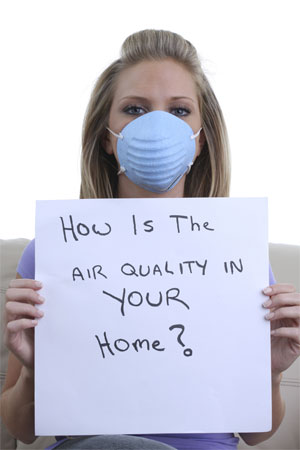Click here to get a quote for Homeowner Insurance
The largest contributor of indoor air pollution is smoke from cook stoves. Households in less developed countries, along with poorer households within the U.S., rely on biomass fuels such as wood, coal, and agricultural waste to heat their homes and cook their foods. Respiratory problems, cancer, asthma, and other health issues, as well as infant mortality, are consequences. Socioeconomic development is seen as one way to minimize indoor air pollution around the world. By decreasing poverty, we can increase people's ability to upgrade to household heating and cooking methods that don't cause health problems, such as oil and electricity, or solar and wind power.
 Indoor air pollution isn't just a problem affecting the poor, however. Even the most expensive, fancy, impressively outfitted homes and offices are full of pollutants. Take this quiz to test your indoor air pollution savvy, and take steps to clean up the air in your indoor environments.
Indoor air pollution isn't just a problem affecting the poor, however. Even the most expensive, fancy, impressively outfitted homes and offices are full of pollutants. Take this quiz to test your indoor air pollution savvy, and take steps to clean up the air in your indoor environments.
Test your air home pollution knowledge:
- True or False: It is only necessary to test for radon in a home built in 1980 or earlier.
- A typical plug-in air freshener will:
- Release as many as 20 different volatile organic compounds (V.O.C.s)
- Actually remove toxins from the indoor environment
- Improve the cleanliness of indoor air by releasing fresh odors
- True or False: Chemical-based cleaning products such as Lysol, Windex, and Clorox, will improve indoor air quality.
- There's a good chance that lead paint still exists on your walls if your home was built:
- After 1990
- Before 1978
- Between 1980 and the present
- True or False: The single most important aspect of indoor air pollution is secondhand cigarette smoke.
Answers:
- False) Even modern homes can have radon problems. Radon is the second-leading cause of lung cancer in the U.S.
- A) A typical plug-in air freshener will release as many as 20 VOCs many of which are known to be toxic or hazardous into the air. As an alternative, use 100% natural essential oil sprays to freshen the air in your home. A simple recipe is 3 drops of lavender essential oil added to a cup of water in a spray bottle.
- False) While they may seem to make surfaces clean, such products actually decrease indoor air quality. Switch to all-natural, inexpensive cleaning products such as vinegar, baking soda, and citrus essential oils, all of which can do just as good a job as their chemical-laden counterparts. Find recipes online.
- B) There's a good chance that lead paint lingers in homes built before 1978.
- True) Secondhand smoke does more to pollute indoor air than anything else.
Questions about your North Carolina home or renters insurance? Call or contact Litaker Insurance today.
